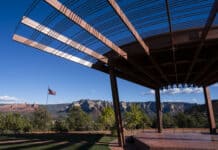The city of Sedona is updating its decades-old signage rules and is looking at off-premises signs, i.e., A-frames promoting live music at a restaurant, a colorful box directing drivers to a garage or estate sale, a temporary sign announcing the date and time of religious services or a sign telling people the location of a Realtor’s open house.
Compounding this is the recent U.S. Supreme Court decision in Reed v. Gilbert, which ruled that municipalities cannot make signage rules that regulate content of signs as those rules are an infringement of our fundamental First Amendment protection of free speech.
Reed was an unusual ruling for several reasons. Firstly, the majority opinion was penned by Justice Clarence Thomas, who rarely writes for the majority due to his outlier stances, and secondly because of zero dissents but three separate concurrences all agreeing that Gilbert’s sign ordinance was unconstitutional.
Justice Elena Kagan’s concurrence, joined by Justices Ruth Bader Ginsburg and Stephen Breyer, agreed that the town of Gilbert’s content-based rule was unconstitutional, but could lead to overhauls of reasonable municipal sign ordinances across the county.
Kagan wrote, “We apply strict scrutiny to facially content-based regulations of speech … when there is any ‘realistic possibility that official suppression of ideas is afoot,’” but, “… we may do well to relax our guard so that ‘entirely reasonable’ laws imperiled by strict scrutiny can survive.”
Legal scholars predict that the number of concurrences will lead to further challenges in the years to come. In the meantime, cities like Sedona are left with a “ban all” or “permit all” option for off-premises signs.
There is no legitimate rationale for banning all signs in Sedona. Ignoring the restrictive noise ordinance that has driven music and nightlife out of the city and weekend traffic congestion that feels like downtown Phoenix after a Diamondbacks’ game, Sedona residents espouse the belief that we still live in a small town, and one thing all real small towns have are temporary signs for all sorts community activities.
To say that temporary signs for garage sales or open houses imperil Sedona’s scenic beauty along the roadway is a moot point. How do I know this? There’s an eight-foot chicken along State Route 179.
Either an eyesore or a work of art, any illusion of maintaining Sedona’s “scenic beauty along the road” remains void as long as it stands. Tourists who come to Sedona are not judging the beauty of our city by our signage, but by the enormous red rock formations in the background.
If a sign directing drivers to a little girl’s lemonade stand on Thunderbird Drive can sully the majesty of Cathedral Rock, our city is doomed. We also know some residents pick up our Friday newspaper not for my stirring editorials nor Daniel Hargis’ outstanding sports coverage nor for Jordan Reece’s amazing photography, but for the garage sale ads listed in our classifieds. That’s fine with us.
Likewise, many residents drive Sedona’s neighborhoods on weekends looking for chaise lounges and antique lamps at garage and estate sales. Even if Sedona goes the strict route and bans all temporary signs, a majority of residents will likely place signs anyway, either in ignorance or defiance of the ordinance.
The city can still regulate things like location, size, height, color, material and function of offpremises signs and should do this instead of a blanket ban of all signs. There is also no need to rush a bad rule into law when the public hasn’t had time to weigh in, but would seem from letters over the years is clearly in opposition to such bans.



















